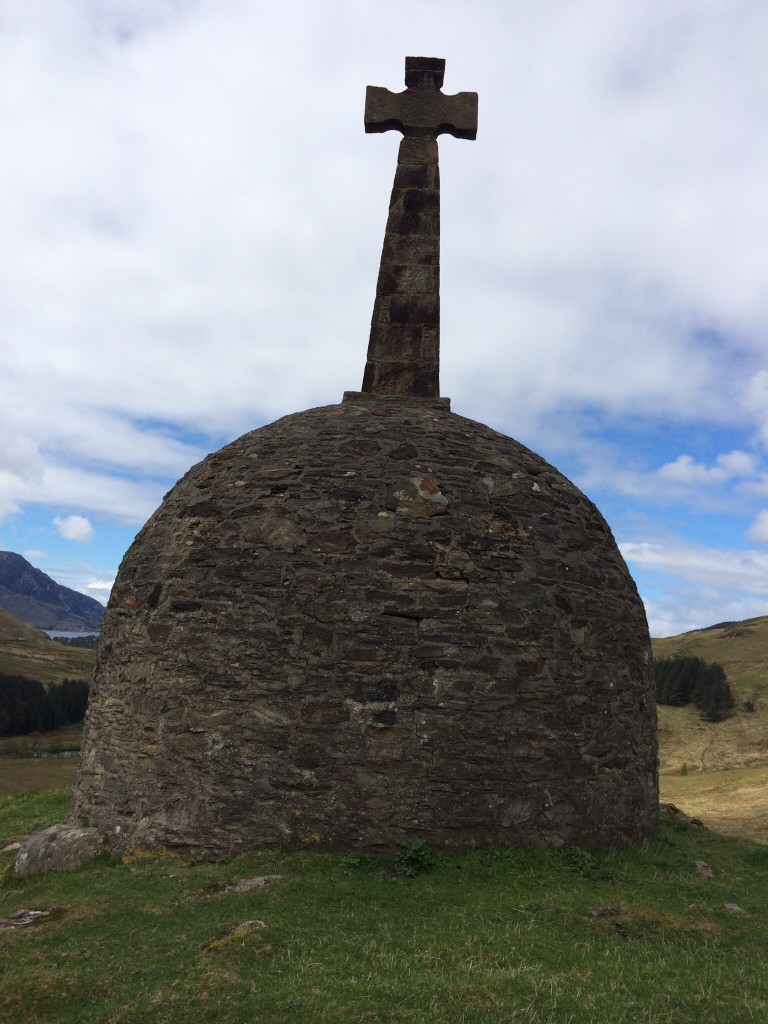After a full Scottish breakfast–that’s bacon and sausage (I passed on the kippers) I headed out to mail a pair of shoes, two books and various outakes to the hotel in Montrose where the celebratory dinner takes place when it’s all over. An hour before the ferry departure people were already streaming to the dock with their stylishly light packs.
With a water bottle filled, mine felt as heavy as ever. But no matter.
Mallaig is a town of stone buildings, steel boats and 800 people. I couldn’t find much about it in the guide book, but a man on the train said that it was once the center of a herring fishery that was valuable enough to extend the railroad to it. Mallaig is at the top of a peninsula; about 20 miles outside it the train stopped at a building that announced itself, on a sign, as the western-most train station in Britain.
The herring schools disappeared in the 1950s, my informant said. Mallaig has fishing boats in its harbor, but probably as many bed-and-breakfasts too.
Here is Mallaig, day and night.


It was sunny when we departed at 10.15 for the one-hour trip to Inverie, a village on another peninsula, called Knoydart. Roger Hoyle, my hiking mentor, had e-mailed two couples he knew were leaving from Mallaig and asked them to look for me on the ferry. Somehow they guessed right. Was it the size of the pack?
It’s a convivial group, heavily accented.
We all gathered at The Old Forge, the local pub, for an exiting pint. This is apparently part of the tradition. Drinking our ales–it was almost noon–out in the sun, I met Graham and Stephen, two Englishmen, and a man with many earrings whose name I missed. The conversation got around to Knoydart, which is a vast, nearly roadless area with almost no inhabitants. They were driven off in the 18th and 19th centuries in what is known as “the Clearances,” a Scottish trail of tears.
Virtually all the land was owned by aristocrats, many absent, who decided at some point the land was more productive with sheep on it than people. So they were forced to leave, in some cases (according to Graham) with their villages burned and the occupants herded to the coast, where they were put on ships for Canada and other places. There was great mortality. I thought this sort of thing only happened in Ireland, but apparently not.
Graham told the story of the Seven Men of Knoydart who, after returning from war decided to eke out a living in Inverie gathering seaweed. They were stopped by the owner of the estate and arrested. It became a cause celebre.
A few dozen yards down the lane on the village hall is a plaque commemorating the 10-year anniversary of the inhabitants buying the town. A little farther along is a beehive monument in stone to the seven men. In Gaelic and English.
Graham also told the story of an English Duke who signed up all his eligible male tenants for military service in one of the wars. Someone asked whether he went.
“Damn, I don’t think I can. I’ve got all these lobsters in the fridge,” Graham said, imagining the answer.
“And I have all these champagne lunches on the calendar,” said the man with the earrings.
We drained our glasses and headed out.
Soon we were out of town on a ridge, yellowish green and striped with rivulets tumbling down to the River Inverie. There were no trees and the clouds nipped the tops of the highest peaks. Behind us was the ocean, although not the open ocean, just one of many sounds with many islands beyond.
A couple of hours in the two-track trail came around a hill and revealed a huge beehive monument topped with a cross on the top of a hill. It looked to me like it might be a church, possibly the remains of a monastery or something.

At the foot of it was Stephen, who was waiting for Graham, who was scrambling up the hill around boulders and outcrops to see what it was.
“He thinks it’s a monument to the people sent off in the Clearances,” Stephen said.
Of course I took off my pack–didn’t need much of an excuse–and scrambled up to see for myself. I met Graham as he was coming down. It wasn’t a monument to the victims of the Clearances. It was the monument to an aristocrat, put up in the 1930s, a little late for that outrage, but probably not others. Graham seemed to have heard of him.
“It’s worth seeing,” he said. “A son put it up for his father, thanking him and saying how great he was. And he was a perfect bastard.”
Hard to know. I’ve never heard of the guy. But you can be sure that his son didn’t carry the stones up the knoll himself.
By the time I got down, taking the less-steep opposite side, Graham and Stephen had gone and the road was empty.
Recent Comments